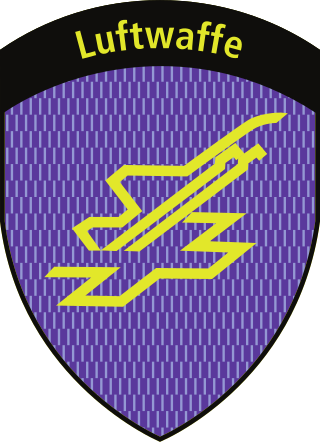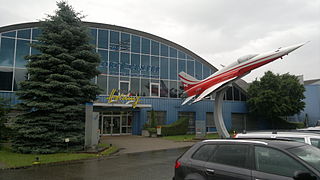
Air traffic control (ATC) is a service provided by ground-based air traffic controllers who direct aircraft on the ground and through a given section of controlled airspace, and can provide advisory services to aircraft in non-controlled airspace. The primary purpose of ATC worldwide is to prevent collisions, organize and expedite the flow of air traffic, and provide information and other support for pilots.

The Swiss Air Force is the air component of the Swiss Armed Forces, established on 31 July 1914, three days after the outbreak of World War I, as a part of the army and in October 1936 as an independent service.

Ground-controlled interception (GCI) is an air defence tactic whereby one or more radar stations or other observational stations are linked to a command communications centre which guides interceptor aircraft to an airborne target. This tactic was pioneered during World War I by the London Air Defence Area organization, which became the Royal Air Force's Dowding system in World War II, the first national-scale system. The Luftwaffe introduced similar systems during the war, but most other combatants did not suffer the same threat of air attack and did not develop complex systems like these until the Cold War era.

Swiss Air-Rescue is a private, non-profit air rescue service that provides emergency medical assistance in Switzerland and Liechtenstein. Rega was founded on 27 April 1952 by Rudolf Bucher, who believed that the Swiss rescue service needed a specialized air branch. Rega mainly assists in mountain rescues, but also operates in other terrains when necessary, especially in life-threatening emergencies. Rega also provides a repatriation and medical advice service for members who experience a medical emergency while abroad and local treatment is not available.
The Australian Advanced Air Traffic System (TAAATS), is the hardware and software system used by Airservices Australia for air traffic control services. It is a paperless, computer-based system, which serves as an aid to civilian air traffic controllers. It does not control aircraft, but gives the user a display of information about an aircraft's position and associated information. It also handles communications and other information exchanges.
Gander Automated Air Traffic System (GAATS) is a proprietary system of Nav Canada used for the oceanic airspace of the Gander Area Control Centre (ACC).

RSE Kriens was a Swiss-developed surface-to-air missile. It never entered service. It was named Kriens after Kriens, a village located in the canton of Lucerne.

The RSA is one of the earliest surface-to-air missiles systems, developed by the Swiss companies Oerlikon-Bührle and Contraves starting in 1947. The missile went through a rapid development process with several upgraded versions, and was the first anti-aircraft missile offered for commercial sale when it was placed on the market in the RSC-50 form. The US tested 25 of the slightly different RSC-51 model under the name MX-1868. No further sales were forthcoming. Several improved versions followed, including the RSC-54, RSC-56, RSC-57 and RSC/RSD-58. These saw small numbers of sales, mostly as training rounds.

TAFLIR is the abbreviation for the "Tactical Flight Radar" of the Swiss Air Force. TAFLIR is used to improve the Recognized Air Picture and to support air traffic control and air surveillance of the Swiss Air Force.

FLORAKO is a Swiss radar system for military and civil aviation. The acronym stands for FLORIDA radar replacement air radar system capable communication system in the initial phase of the project meant the name FLORES RALUS KOMSYS and emerged from the project name of the sub-systems. There are four surface to air missile tubes located on the site.

The Target allocation radar TPS-1E is an omnidirectional pulse radar device. It was used from 1958 until 1989 by the Swiss Air Force. It was also used by German army (Heer) air defence reconnaissance platoons up until the early 1990s.

The Super Fledermaus, known in Swiss service as the Feuerleitgerät 63, Flt Gt 63, is a pulse-radar fire control system, 111 of these systems were in service with the Swiss Air Force from 1965 to 1977. Under the lead of Contraves, the Super Fledermaus fire control system was jointly developed and produced by ten companies. It replaced the Fire control radar Mark VII in Swiss service, and was in turn replaced by the Skyguard system.

The Flieger Flab Museum is located in the Canton of Zurich in Dübendorf on the grounds of Dübendorf Air Base. In the museum, 40 airplanes and helicopters are displayed, with the collection divided into distinct eras: pioneers and World War I, the 1930s, World War II and the postwar period, the beginning of the jet age, the development of jet fighters, the Cold War, and arms reduction.

The LGR-1 was used by Swiss Air Force from 1948 until 1955 for positioning the planned radar air surveillance system. It is now in the Flieger-Flab-Museum at Dübendorf.

The SFR Airspace monitoring and management system was the first Airspace monitoring and management system of the Swiss Air Force.

Dübendorf Military Airport was a military airfield of the Swiss Air Force northeast of Dübendorf in Switzerland, located east of Zürich.

Air14, also named 100 years Swiss Air Force was an international air show held by the Swiss Air Force in late August and early September 2014 at Payerne Air Base, Switzerland. It claimed to be the biggest airshow in Europe of 2014.

Fliegerstaffel 19 of the Swiss Air Force is a militia squadron equipped with Northrop F-5E and forms together with Fliegerstaffel 18 Fliegergeschwader 14. The home base of the fliegerstaffel 19 is Sion Airport. The "Fliegerstaffel 19" carries as a coat of arms a stylized swan on a blue background.

The Berufsfliegerkorps (BFK) are the professional pilots of the Swiss Air Force.
The Militärhistorische Stiftung des Kantons Zug MHSZ is a foundation consisting of a group of Military Museums in the canton of Zug with the purpose of safeguarding and cultivating the military heritage of the Swiss Confederation in the canton of Zug.

























